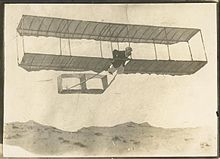George Augustine Taylor
George Augustine Taylor (born August 1, 1872 in Sydney , New South Wales , † January 20, 1928 in Sydney) was an Australian journalist and inventor.
He grew up as the second son of the fruit merchant George Faulty Taylor and his Irish wife Annie Maria, née McFadden. He was particularly interested in drawing and in the 1890s he worked as a caricaturist and cartoonist for The Bulletin and the Punch . He was a member of the Dawn and Dusk Club as well as the Royal Art Society of New South Wales and part of the Australian Bohème .
Around 1900 his interests changed in part and he turned to innovations such as the telephone , radio technology and spiritualism . He was enthusiastic about technology and strongly represented nationalist ideas. He married the draftsman and architect Florence Mary Parsons, who was seven years his junior, on April 3, 1907, and with her support became a magazine publisher. His small publishing house published the magazines Building , Construction and Local Government Journal , Australasian Engineer , Radio Journal of Australia , Harmony , Young Australia , among others . His modernist views show up from 1912 to 1914 in the great support for the urban plans for Canberra by Walter Burley Griffin . He advocated " New Journalism " and helped found the Institute of Local Government Engineers of Australasia in 1909, the Wireless Institute of New South Wales in 1910, and the Town Planning Association of New South Wales in 1913.
From 1908 he became interested in aviation. He contacted the already withdrawn Lawrence Hargrave and constructed glider planes according to his box kite construction scheme. In December 1909 he tested this with his wife in Narrabeen in New South Wales . These gliding flights were the first controlled flight with aircraft heavier than air in Australia, as well as the first flight by a woman in Australia. Just three months later, Harry Houdini carried out the first powered flight in Australian aviation history with an imported airplane , and Taylor gave up his ambitions to build a powered airplane himself.
Also in 1909, Taylor wrote requests to the Australian government to establish an air force and endeavored to develop military applications for radio and telephony, with success. For his foundations in military cartography, he was inducted into the Royal Geographical Society of London , and with theories about life on the moon , he joined the Royal Astronomical Society . In drawn science fiction stories, Taylor promoted superior technology as the sole means of protecting Australia from its enemies. In 1914 the Taylor couple traveled to the USA , Taylor had been an enthusiastic supporter of Theodore Roosevelt for a long time . In October 1914, Taylor joined Australia's Light Cavalry and published fictional stories showing Europe as divided between militarists and humanists - the former scientifically and progressively thinking, the latter allied with the Germans. On May 30, 1916, Taylor launched Soldier magazine , in which he demanded that returned soldiers should get important jobs in politics and society. After the 1918 armistice, Taylor called for war memorials to be built to honor and inspire the military and for historic buildings to be included in urban planning.
In 1919 Taylor founded the Institution of Engineers, Australia , in 1922 the Australian Inventions Encouragement Board and in 1923 the Association for Developing Wireless in Australia . In his opinion, wireless technology should serve the community rather than the for-profit corporations. Taylor also continued his pre-war work on wireless image transmission (see television ) and was able to transmit plans and drawings with color information in the 1920s. In the mid-1920s he was also pacifist , advocating the League of Nations and promoting Australia abroad as a haven of peace. The Taylors attended the 1924 London World's Fair as experts in home appliances and design. The publication of the Soldier was discontinued, from January 1925 Australian Home (later Commonwealth Home ) was published instead .
In an epilepsy attack , Taylor drowned in his bathtub on January 20, 1928, he was cremated according to the Anglican rite . His wife Florence outlived him by forty years, listing all of his eleven magazines except for Building (later Building, Lighting and Engineering ), Construction and Australasian Engineer . She continued these three magazines as editor, traveled the world and was also inducted into the Order of the British Empire as Officer in 1939 and Commander in 1961 . She died on February 13, 1969.
swell
| personal data | |
|---|---|
| SURNAME | Taylor, George Augustine |
| BRIEF DESCRIPTION | Australian journalist, inventor and aviation pioneer |
| DATE OF BIRTH | August 1, 1872 |
| PLACE OF BIRTH | Sydney , New South Wales |
| DATE OF DEATH | January 20, 1928 |
| Place of death | Sydney , New South Wales |
